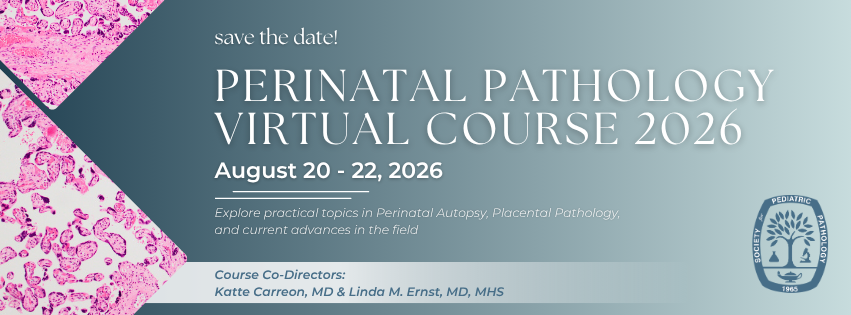
Perinatal Pathology Virtual Course 2026
August 20-22, 2026
Registration to open in 2026
Live virtual course
Recordings available for purchase starting September 2026
Course Co-Directors: Katte Carreon, MD & Linda M. Ernst, MD, MHS
Preliminary Agenda:
DAY 1 – PERINATAL AUTOPSY
-
Approach to Perinatal Autopsy - Linda Ernst, MD MHS
-
Normal Fetal Histology and Common Abnormal Findings - Linda Ernst, MD MHS
-
Perinatal Neuropathology - Angela Viaene, MD, PhD
-
Segmental Analysis of Cardiac Anatomy - Katte Carreon, MD
-
Skeletal Evaluation & Skeletal Dysplasia - Teresa Victoria, MD
-
The Ona Faye-Petersen Perinatal Pathology Lecture- Perinatal Global Pathology Capacity Building (tentative topic) - Drucilla Roberts, MD
DAY 2 – PLACENTA
-
Gross Placental Pathology- Beverly Rogers, MD
-
Maternal and Fetal Vascular Pathology - Sanjita Ravishankar, MD; Charlotte Kim, MD
-
Inflammatory and Miscellaneous Placental Conditions - Jefferson Terry, MD
-
Evaluation of the Twin Placenta- Rebecca Linn, MD
-
Leveraging Placental Insights to Inform Clinical-Decision Making - Sunitha Suresh, MD
-
Integrating Digital Pathology into Placental Pathology Practice - Jeffery A Goldstein, MD
*Shaken, Not Stained: Mixology + Friday Trivia Hour
A relaxed virtual social hour bringing together great drinks and great minds-- featuring a guided mixology session using a mailed custom cocktail kit sent to all attendees and a round of pathology-themed trivia.
DAY 3 – SPECIAL TOPICS
-
Approach to Products of Conception - Jonathan Hecht, MD, PhD
-
Pre-eclampsia: Updates and Impact on Life Course- W. Tony Parks,MD; Janet Catov, PhD, MS
-
Virtual Perinatal Autopsies(Institutional experience and implementation) - Ciaran Hutchinson. MBBS, PhD, FRCPath; Rebecca Linn, MD
-
An Extra-Uterine System to Physiologically Support the Extreme Premature Lamb - Alan Flake, MD
-
“A Case That Taught Me the Most” Case Presentation & Panel - Linda Ernst, MD MHS; Terry Morgan, MD PhD, Virginia Duncan, MD; Philip Katzman, MD
|